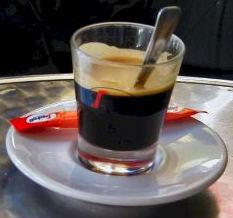L' Espresso is the name of an Italian newspaper.
Espresso is a strong, flavorful coffee brewed by forcing hot water through finely ground coffee beans. In Italian, espresso means "pressed out" or "express".
Espresso differs greatly from the common drip brewed coffee drink in its thick concentrated consistency, and robust flavor. Due to its potency, straight espresso (espresso served without sweetener or milk, analogous to black coffee) is considered by some to be an acquired taste, and is served in small amounts called shots. Many coffee afficianados order their single or double with a little glass of cold still water to clear the palate.
Espresso is often used as the foundation for other drinks, such as lattes, cappuccinos, mochas, and many more. A key component in the flavor of espresso is a golden foam composed of oils, proteins, and sugars, called crema which floats on the surface.
Espresso Beans
Espresso is usually derived from a certain type of coffee bean; Coffea arabica commonly known as Arabica, but the other variety, Robusta, is also used in some espresso blends. Arabica trees require more care in growing, and are therefore more expensive. Arabica beans are considered to be superior to the more common Caffea canephora (known as Robusta) beans, which are typically used for filler in commercial drip brew coffee, due to their lower level of caffeine and acidity, and their higher amounts of flavor and aroma. The roast of the beans varies from dark to light, depending on the desired taste. For making espresso, the beans are ground very finely, unlike coarser drip-style grounds.
Brewing Process
The process of making espresso is considered by many to be an art form, and people who are thought to have mastered their technique are referred to as baristas. This belief is due, in part, to the many nuances which can be altered to effect the final product, as well as the fact that high quality espresso machines can be too expensive for most people.
Techniques for making espresso vary from person to person, and depend largely upon the machine used. First, a metal "basket" with a perforated bottom is filled with coffee powder, and pressed down with a tamp to form a "puck" at the bottom of the basket. The basket is fitted to the espresso machine in a sealed holder, which directs the coffee into the mug. Heated water in a pressure sealed tank is pumped through the compressed coffee and into the cup. For more specific details on espresso brewing techniques, see espresso machine.
Italians, who invented espresso, insist that there are four Ms that are key to a good espresso: miscela (blend), macinazione (grind), macchina (machine), and mano (hand).
See also: Coffee, Coffee (drink), Caffé, Cappuccino, Coffeehouse, Demitasse, Drip brew, Espresso con panne, Espresso machine, Latte, Mocha, Moka, Ristretto
